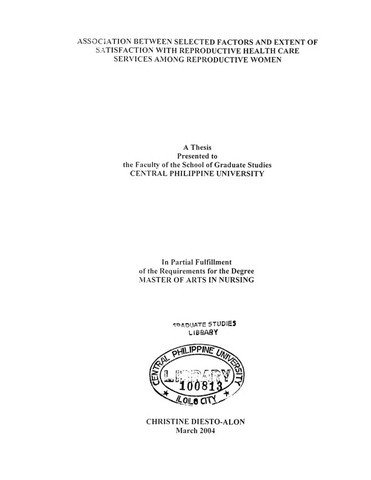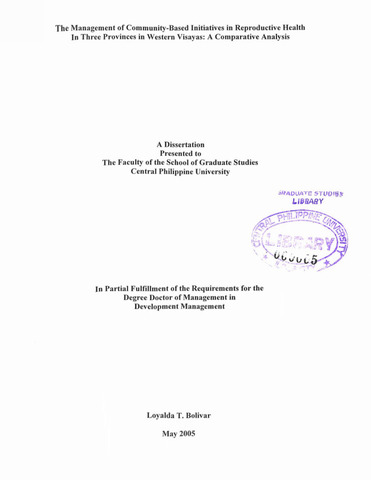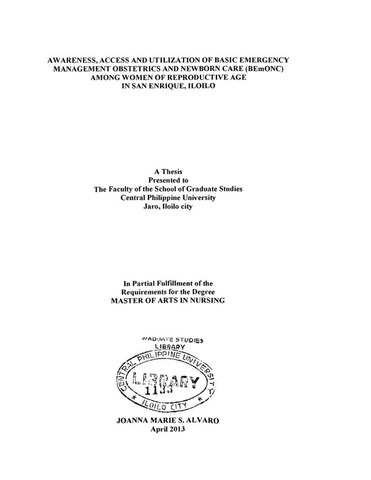Association between selected factors and extent of satisfaction with reproductive health care services among reproductive women

Page views
745Дата
2004Автор
Thesis Adviser
Defense Panel Chair
Share
Metadata
Показать полную информацию
Аннотации
Pregnancy and childbirth are the greatest risks that many women face during their reproductive years. A report from Johns Hopkins University indicates that more than half a million women from the developing countries die each year during pregnancy and childbirth (Population Reports, 1988).
Women are not only at high risk during pregnancy but also in great danger of contracting Human Immunodeficiency Virus and sexually transmitted diseases (HIV/STD), complications due to abortion, and domestic violence or abuse. Several studies have shown that in Kampala, Uganda, the highest reported rate of HIV infection in 1987 was one in every four women (Population Report, 1988).
The most common victims of violence are women. Statistics from the Department of Social Welfare and Development, Philippines, revealed that, in 1998, nearly 75 percent of women were victim-survivor of domestic violence (http://www.inq7.net/opi/2001/dec/15/text/opi-rjdavid-l-p.htm). The study of David, Chin and Herradura (1998) showed that 37.4 percent of the women in Region VI had been victims of domestic violence.
Women’s vulnerability to become victims of abuse is not only limited to domestic violence. Abortion has also caused many pains and sufferings among women. The Philippine Daily Inquirer (2003) quoted a study by Cabigon of the University of the Philippines Population Institute, Manila that 17 percent of the 1,169, or close to 200 women respondents, admitted to have undergone abortion. In addition, as many as 750,000 women underwent induced abortion annually in various illegal clinics all over the Philippines.
Despite efforts by the government to set up health programs to limit pregnancy and achieve safer delivery, many women still die due to complications.
Every Filipino deserves the right to receive reproductive health care services. However, not all reproductive health care services are available in health care facilities all over the country.
A survey in the province of Capiz in 2001 revealed that in three Rural Health Units (RHUs) only Family Planning (FP), Maternal Child Health (MCH) and Reproductive Tract Infections (RTI), Sexually Transmitted Diseases (STD), Human Immunovirus/Acquired Immune Deficiency Virus (HIV/AIDS) services were available and only one was offering Adolescent Reproductive Health (ARH) services. All the three Barangay Health Station (BHS) did not have services for RTI/STD/HIV/AIDS, nor were there services provided for labor and delivery (David, 2002).
Family Planning services and supplies are not available to many people in many parts of the world. In Africa, evidence from Demographic and Health Surveys (DHS) indicated a large unmet need for FP services for spacing births and limiting childbearing (Barry, 1996). Even in clinics where these services were available, access to and utilization of these services were limited by certain physical, economic and social factors such as distance of clinics, lack of transportation fare, and lack of knowledge about the available services. David’s (2002) report stated that professional attention, prompt care and meeting clients’ expectations were the reasons for satisfaction in the utilization of the health care services.
Cognizant of the health risks faced by women of reproductive age, the government enacted RA 7192 entitled “An Act Promoting the Integration of Women as Full and. Equal Partners of Men in Development and Nation-Building and for Other Purposes” The act states that:
“The State recognizes the role of women in nation building and shall ensure the fundamental equality before the law of women and men. The State shall provide women rights and opportunities equal to those of men” (Sec.2) (PPMP, Directional Plan 2001-2004).
This Republic Act is primarily aimed to help couples meet their reproductive goals towards a satisfying and safer sex, health responsibility and well-being. Men and women, either sexually active or not, need to protect themselves against STDs, including HIV/AIDS.
Former Health Secretary Dr. Alberto Romualdez, Jr., stated that although major improvements have been observed in the past 50 years in the Philippine health situation, there are still many challenges to be met. He emphasized that the health status of people in the Philippines is not as good as those of our neighboring countries. He cited that the country’s Infant Mortality Rate (IMR) and the Maternal Mortality Rate (MMR), the two of the most sensitive indicators of health sector performance, have declined during the 1990s. Infant Mortality rate is 150 per 1,000 live births, which is still higher than the World Health Organization (WHO) standards for control pegged at 35 deaths per 1,000 live births (Health and Home, Jan-Feb 2001).
For effective program management, feedback mechanism regarding client’s satisfaction with the RH services is very important. Despite its changing face, no one can argue that client satisfaction is not given enough importance. Patients comply with treatments and maintain a relationship with the provider. While there are many foreign studies regarding client satisfaction on Reproductive Health Care Services (RHCS), only a few local studies have been conducted.
Realizing the shortage of studies on client satisfaction in the delivery of RHCS, the researcher decided to determine the concerns and needs of the clients about reproductive health and their satisfaction with the services they receive. Information on client satisfaction in the delivery of RHCS has been recognized as an important component that can affect the health and well-being of the family and the community.
Major Findings
The study revealed that the majority of respondents were married and in their mid thirties. Seven in every 10 clients finished high school and college but only few of them were gainfully working.
Almost all respondents’ found the clinic hours of the health center convenient and clinic waiting time reasonable because the health centers were within walking distance from their residence. Waiting time was only between 5 -20 minutes.
Most mothers indicated a desire of being given attention when they went to the clinic for consultation and be treated professionally by the health care provider. This means that client satisfaction largely depends on the behavior of the health care providers, how the health care provider dealt with client, how the clients have been served at the centers, and how their needs are met.
Among the four demographic variables (age, civil status, educational attainment, occupation) only occupation of the women is significantly associated with perceived convenience of clinic hours, while only civil status of the women is significantly associated with perceived convenience of clinic waiting time. Furthermore, the respondent perception regarding the reasonableness of clinic waiting time is significantly related to satisfaction. The client who found waiting time convenient tended to be more satisfied with the RH services.
In terms of accessibility to RH services, it was found that travel time to the health center was not significantly associated with clients’ satisfaction with reproductive health care services. This means that distance and ease of travel to the health center improve access to RH services, and the greater the clients’ access to services has resulted to greater likelihood of utilization, and consequently, satisfaction with the RH services.
All the demographic variables (age, educational attainment and occupation) were not significantly associated with satisfaction except the civil status of the client. This means that client civil status is an important factor in determining client satisfaction.
Conclusion
Based on the findings of this investigation the following conclusions were drawn:
1. The health centers are in the right place where they are now. They are accessible to clients and are convenient to all. There is no need for relocation of the center in other areas that may make it more convenient. David’s findings were further validated by this study that the clinic hours at the Service Delivery Points (SDPs) were convenient because clinic hours in most Rural Health Units (RHUs) were synchronized with market days, opened early and stayed open even at noon time, and majority of clients reported that they found the waiting time in the clinic reasonable.
2. The majority of RH clients expressed that the SDPs were accessible because the location of the health centers were near the clients’ house. This factor may have contributed to the satisfaction with the services of the center.
3. The majority of the RH clients reported that the clinic schedule were convenient because clinic hours were being synchronized with market days. The more accessible the RH services, the more likely that client will be satisfied.
4. There were some RH services that were less utilized in the health centers, like Adolescent Reproductive Health (ARH), Pre-marital Counseling (PMC), and Infertility Services, because these services were not available in other health centers.
5. The findings substantiate the theory of Goal Attainment by Imogene King, that goal attainment is a process of transaction toward effective nursing care and is a product that is equated with effective nursing care and satisfaction. When client goes to the clinic and gets the RH services he needs, he is more likely to be satisfied with the services.
6. The findings showed that RH services had been delivered effectively to clients because majority of them expressed satisfaction with the services they received. The health centers were accessible, and the clinic schedule convenient to them. The greater the utilization of the services and the more they are accessible to clients, the more helped enhanced will be people’s cooperation in an organization, the more improved community participation will be.
Recommendations
On the basis of conclusions on this investigation, the following recommendations are given:
1. Since there is no need to transfer the centers into a more convenient and accessible place, the government only needs to maintain the centers, if not further enhance services among the clientele.
2. Since most of the clients are very satisfied with the RH services, the government and the RHUs only need to maintain the quality of the RH services in their respective health units.
3. Since ARH, PMC and Infertility services are the least utilized services, the government and other Health agencies should become more convinced of the need for personnel training related to these services and their elements to make them available in the health centers, thus to motivate and encourage more women to utilized the RH services.
4. As need arises, future researches are encouraged to keep health providers abreast with the changing times especially with the people health care needs. Future research will not only focus with women of reproductive age but must also include their sexual partners. Likewise, researches should be conducted on how the health status of the children affect women during their reproductive age, and the other factors that may affect womens’ health.
Описание
Abstract only
Suggested Citation
Alon, C. D. (2004). Association between selected factors and extent of satisfaction with reproductive health care services among reproductive women (Unpublished Master's Thesis). Central Philippine University, Jaro, Iloilo City.
Type
ThesisТематика
Keywords
Department
School of Graduate StudiesDegree
Master of Arts in NursingShelf Location
GSL Theses 610.73072 A172
Physical Description
xviii, 71 leaves
Collections
Связанные элементы
Просмотр элементов, связанных по названию, автору, создателю или теме.
-
The management of community-based initiatives in reproductive health in three provinces in Western Visayas: A comparative analysis
Bolivar, Loyalda T. (2005)This study aimed to describe and compare the management of community-based initiatives in terms of inputs, processes used in implementation, actual project performance, facilitators and constraints in project planning and ... -
Perceived wellness among the teaching personnel in a private higher education institution: Status, challenges, and practices as bases for the formulation of a wellness program
Alicante, Jelvit Amor C. (2022-06)This survey research aimed to identify the perceived wellness status, wellness challenges, and wellness practices among the 124 randomly selected full-time teaching personnel in a private higher education institution. ... -
Awareness, access and utilization of Basic Emergency Management Obstetrics and Newborn Care (BEmONC) among women of reproductive age in San Enrique, Iloilo
Alvaro, Joanna Marie S. (2013)Women’s utilization of maternal health care facility is an important health issue with regard to the wellbeing and survival of both the mother and her child during childbirth. There are certain factors however that inhibit ...





